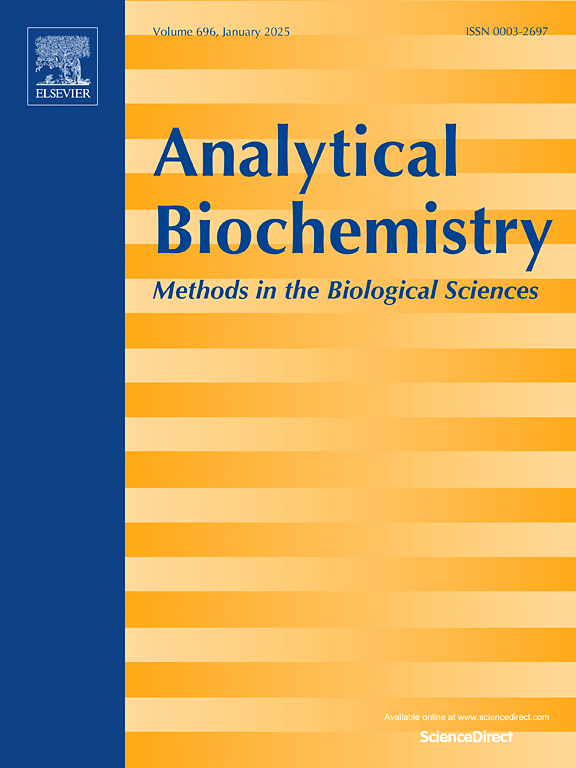耐甲氧西林金黄色葡萄球菌和易感金黄色葡萄球菌浮游生物和生物膜的脂质组学比较图谱。
IF 2.6
4区 生物学
Q2 BIOCHEMICAL RESEARCH METHODS
引用次数: 0
摘要
金黄色葡萄球菌是一种重要的人类病原体,可导致危及生命的急性和慢性感染,通常与生物膜有关。本研究利用液相色谱-质谱(LC-MS)和核磁共振(NMR)光谱对浮游生物和生物膜培养物中的耐甲氧西林(MRSA)和甲氧西林易感(MSSA)金黄色葡萄球菌菌株进行了脂质体组学比较分析。所开发的方案利用金黄色葡萄球菌 USA300 LAC(MRSA)和金黄色葡萄球菌 Newman(MSSA)成功地区分了不同生活状态(浮游生物和生物膜)和生长介质(胰蛋白酶大豆肉汤和脑心输液)下的菌株。LC-MS 和 NMR 脂质组学分析揭示了以下几类细菌脂质的总体差异和特殊差异:磷脂酰甘油、二酰甘油、单糖苷二酰甘油、二糖苷二酰甘油和心磷脂。在生物膜状态下,其中大多数类别的脂质含量都较高。生长介质的差异非常明显,而 MRSA 和 MSSA 之间的差异不太明显,但仍可检测到。此外,我们还提供了数百种未知化合物的数据,这些化合物会因生活状态、菌株背景或生长介质而有所不同。这项研究有助于深入了解金黄色葡萄球菌脂质组成的动态性质,所使用的方法也适用于其他生物。本文章由计算机程序翻译,如有差异,请以英文原文为准。

Comparative lipidomics profiles of planktonic and biofilms of methicillin-resistant and -susceptible Staphylococcus aureus
Staphylococcus aureus is a significant human pathogen causing acute life-threatening, and chronic infections often linked to biofilms. This study conducted a comparative lipidomic analysis of a methicillin-resistant (MRSA) and a methicillin-susceptible (MSSA) S. aureus strain in both planktonic and biofilm cultures using liquid chromatography-mass spectrometry (LC-MS) and nuclear magnetic resonance (NMR) spectroscopy. The developed protocol successfully differentiates between the strains in various living states (planktonic and biofilm) and growth media (Tryptic Soy Broth and Brain Heart Infusion) using S. aureus USA300 LAC (MRSA) and S. aureus Newman (MSSA). LC-MS and NMR lipidomics profiles revealed global differences and particular ones among the following classes of bacterial lipids: phosphatidylglycerols, diacylglycerols, monoglycosyldiacylglycerols, diglycosyldiacylglycerols, and cardiolipins. Lipid content was higher in the biofilm states for most of these classes. Growth media differences were significant, while differences between MRSA and MSSA were less pronounced but still detectable. Additionally, we provide data on hundreds of unknown compounds that differ based on living state, strain background, or growth media. This study offer insights into the dynamic nature of S. aureus lipid composition and the used methods are adaptable to other organisms.
求助全文
通过发布文献求助,成功后即可免费获取论文全文。
去求助
来源期刊

Analytical biochemistry
生物-分析化学
CiteScore
5.70
自引率
0.00%
发文量
283
审稿时长
44 days
期刊介绍:
The journal''s title Analytical Biochemistry: Methods in the Biological Sciences declares its broad scope: methods for the basic biological sciences that include biochemistry, molecular genetics, cell biology, proteomics, immunology, bioinformatics and wherever the frontiers of research take the field.
The emphasis is on methods from the strictly analytical to the more preparative that would include novel approaches to protein purification as well as improvements in cell and organ culture. The actual techniques are equally inclusive ranging from aptamers to zymology.
The journal has been particularly active in:
-Analytical techniques for biological molecules-
Aptamer selection and utilization-
Biosensors-
Chromatography-
Cloning, sequencing and mutagenesis-
Electrochemical methods-
Electrophoresis-
Enzyme characterization methods-
Immunological approaches-
Mass spectrometry of proteins and nucleic acids-
Metabolomics-
Nano level techniques-
Optical spectroscopy in all its forms.
The journal is reluctant to include most drug and strictly clinical studies as there are more suitable publication platforms for these types of papers.
 求助内容:
求助内容: 应助结果提醒方式:
应助结果提醒方式:


